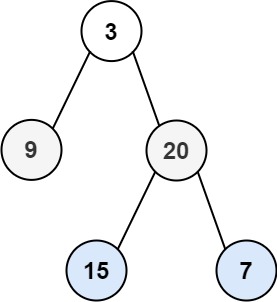62. Binary Tree Level Order Traversal
Problem Statement
Given the root of a binary tree, return the level order traversal of its nodes' values. (i.e., from left to right, level by level).
Example 1:

Input: root = [3,9,20,null,null,15,7] Output: [[3],[9,20],[15,7]]
Example 2:
Input: root = [1] Output: [[1]]
Example 3:
Input: root = [] Output: []
Solution
from collections import deque
# Definition for a binary tree node.
class TreeNode:
def __init__(self, val=0, left=None, right=None):
self.val = val
self.left = left
self.right = right
class Solution:
def levelOrder(self, root: TreeNode) -> list[list[int]]:
result = []
if not root:
return result
queue = deque([root])
while queue:
level_size = len(queue)
current_level_nodes = []
for _ in range(level_size):
node = queue.popleft()
current_level_nodes.append(node.val)
if node.left:
queue.append(node.left)
if node.right:
queue.append(node.right)
result.append(current_level_nodes)
return result
Explanation
This problem is a classic application of Breadth-First Search (BFS).
Core Idea: BFS explores a tree level by level. We use a queue to keep track of the nodes to visit.
-
Initialization:
- Create an empty list
resultto store the level order traversal. - If the
rootisNone, return an emptyresult. - Initialize a
deque(double-ended queue) and add therootto it.
- Create an empty list
-
Level-by-Level Traversal:
- The
while queue:loop continues as long as there are nodes to visit. - Inside the loop, we first get the
level_size(the number of nodes currently in the queue). This is crucial because it tells us how many nodes belong to the current level. - Create an empty list
current_level_nodesto store the values of nodes at the current level. - Iterate
level_sizetimes:- Dequeue a
nodefrom the front of thequeue. - Append
node.valtocurrent_level_nodes. - If the
nodehas aleftchild, enqueue it. - If the
nodehas arightchild, enqueue it.
- Dequeue a
- After processing all nodes at the current level, append
current_level_nodesto theresult.
- The
-
Return Result: Once the
queueis empty, all nodes have been visited, andresultcontains the level order traversal.
Time and Space Complexity:
- Time Complexity: O(N), where N is the number of nodes in the binary tree. Each node is visited and processed exactly once.
- Space Complexity: O(W) in the worst case, where W is the maximum width of the tree (the maximum number of nodes at any single level). In a complete binary tree, W can be N/2, so O(N). In a skewed tree, W is 1, so O(1).